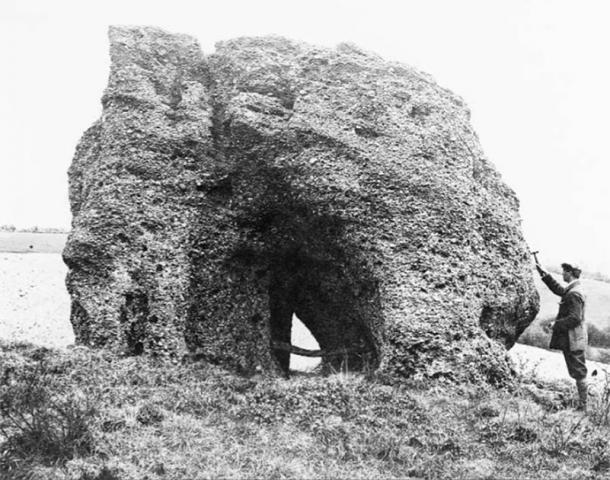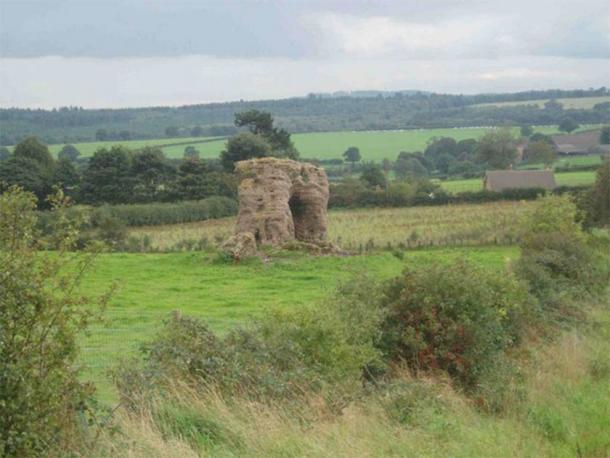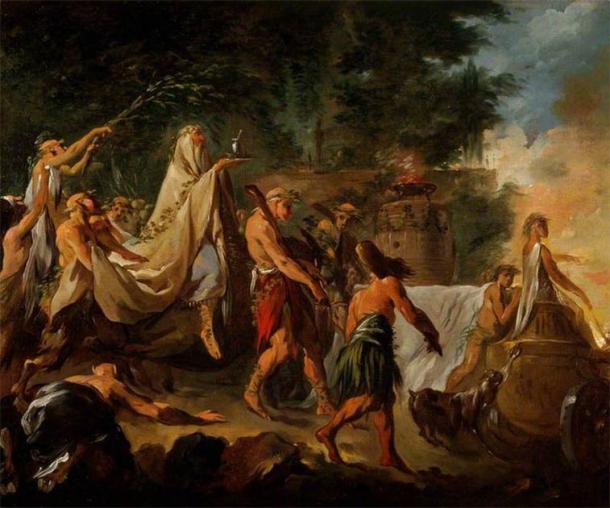Referred to locally as the “Druid Stone” or “Altar Stone,” this monumental stone stands about 4 meters (13 feet) high on private land in the village of Blidworth, England, and is viewable from a public footpath. A man-made passage has been cut through the center of the rock. A British archaeoastronomer, expert in exploring skyscapes and how prehistoric peoples engaged with the sky, has considered how this immense rock “might” have been used by the pre-Romanic druids.

A 1911 photo of the Blidworth Druid Stone viewed from the west shows the monument hasn’t changed in the last hundred years. ( British Geological Survey materials / NERC )
Druids, Druids Everywhere
The druids were high-ranking religious leaders and social elites in pre-Christian European Celtic cultures. They served as legal authorities, doctors, keepers of poems and spiritual traditions, and advisors to political leaders, conducting their ritual affairs in open air settings like earlier Neolithic standing stone circles, natural grottoes and caves.
However, just because the Blidworth Druid Stone is known as a druid stone, does not mean it had anything to do with the druids. In Victorian England , as an interest in all things druidical surged, thousands of natural boulders and archaeological sites were incorrectly associated with the druids. Today, one of the tasks of the modern archaeologist is to investigate so-called druid sites to determine if they had anything to do with the druids, or not.
A 2015 statement on the Blidworth Historical Society website stated: “Since March 1999 the site of the Druid Stone has been recognized by Newark and Sherwood District Council as a grade one geological site of regional importance to nature conservation.” Note that the Druid Stone was listed officially as a site of geological, and not archaeological, interest.

The monumental Blidworth Druid Stone, said to be a sediment deposit left behind after the last Ice Age, stands about 4 meters (13 feet) high on private land near the village of Blidworth and is viewable from a public footpath. ( Jim Thornton / CC BY-SA 2.0 )
How Prehistoric Peoples Engaged with the Sky
Dr. Dan Brown is an associate professor of astronomy at Nottingham Trent University (NTU) who specializes in archaeoastronomy, the multidisciplinary study of how people in the past interpreted phenomena in the sky. In an article about the “out of place stone” in the Nottingham Post , Brown is quoted as saying that he suspects that the Blidworth Druid Stone might have been deliberately aligned with the sun, and that it may have been a central feature in ancient rituals . However, Brown’s academic skepticism is made clear in the article when he stresses that it is “always difficult to judge these things.” His interest was peaked because “the shape carved out the middle does appear to be man made.” Brown emphasizes: “I have not been there, but it’s on my list.”
Based only on pictures and armchair research, Brown explains that the window in the eroded glacial deposit “provides a whole quadrant in the sky,” while the 6 foot cut-out passage is in alignment with the May Day sunrise, a holy day celebrated by pagans and druids as the beginning of the summer season in a festival known as Beltane, which takes place on May 1st. In describing what the hole could have been used for, Brown says that it might have provided “ a window to look out from the stone .” However, he continues to explain that the issue with this theory is that no secondary stone, or outlier, has been found aligning with the main stone’s window.

18th century painting of a druid ceremony by Noël Hallé. ( Public domain )
A Beltane Alignment, or Figment of Imagination
The Blidworth Historical Society claim druidic practices associated with the stone are recorded in local folklore and writing. In the late 19th century the vicar of the Blidworth Parish, Rev. Richard Whittworth, said that the view from the stone’s cut-out “marks sunrise on the summer solstice.” However, in the 1970s, Peter Hannah, Frank Earp and Barry Christian, from the Nottingham Hidden History Team, tested this theory and determined it to be incorrect. The so-called Blidworth Druid Stone actually aligned with the rising sun on Beltane, when viewed around 1800 to 1700 BC.
Even though Brown suspects this Beltane alignment to have been deliberate, he clarifies that “if you assume it to align with something and set out to test this, then it can easily be seen as such,” meaning that if you draw a line far enough from any one spot in the English countryside, that line will eventually cross archaeology. Accordingly, the diligent researcher remains “dubious” about such findings. Brown added that while this “could be a nice alignment” it’s hard to say whether it was intentional, and created though “high precision” surveying work. Before archaeologists start to make such bold claims, “more archaeological work needs to be done to give this theory basis.”
Top image: British archaeoastronomer claims that the Blidworth Druid Stone “might” have been deliberately aligned with the sun, and that it “may” have been a central feature in ancient druid rituals. But more archaeological study is needed before reaching any conclusions. Source: Deborah McDonald / CC BY-SA 2.0
By Ashley Cowie
 RSS Feed
RSS Feed















 August 10th, 2020
August 10th, 2020  Awake Goy
Awake Goy  Posted in
Posted in  Tags:
Tags: 













